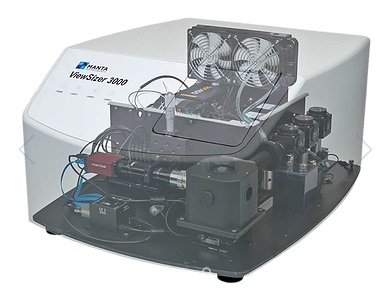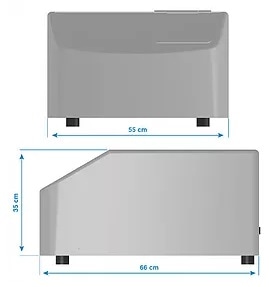HORIBA Scientific’s ViewSizer™ 3000 delivers revolutionary enhancements to particle tracking technology, including proprietary illumination and detection techniques that enable innovative visualization, measurement, and number concentration of nanoparticles over a broad range of sizes.
Similar to conventional NTA, the ViewSizer™ 3000 visualizes scattering from individual nanoparticles in suspension. This data is then used to establish particle movement and derive the particle size with the help of the Stokes-Einstein relationship.
Subsequently, making use of the known illuminated and imaged sample volume, particle number concentration is easily identified. Therefore, from a single measurement, two critical pieces of information are established: particle concentration and particle size distribution.
By adding three variable light sources (green, blue, and red), the instrument can select the ideal conditions for the examination of any sample, thereby overcoming the drawbacks of NTA when examining polydisperse samples and allowing the visualization of a considerably wider range of particle sizes.
Moreover, by adding the sample to a user-friendly (and clean) cuvette, the ViewSizer™ 3000 can repetitively “analyze and stir,” delivering a much more reproducible result. Since the sample is observed in a vertical orientation, it is ideal for visualizing processes such as crystal dissolution or protein aggregation.
Therefore, whether one is using NTA for the examination of exosomes or other microvesicles or for complicated nanoparticle kinetic processes, the ViewSizer™ 3000 is an advanced technology, enabling better analysis in every laboratory.

Key Features of the ViewSizer™ 3000
- Highly appropriate technology for polydisperse samples
- High resolution of PSD and visualization
- Enumeration of various particle constituents in the same sample
- Ideal for tracking nanoparticle kinetics
Applications
The following applications can realize the advantages of enhanced particle analysis using the ViewSizer™ 3000:
- Chemical mechanical polishing
- Batteries
- Colloid stability
- Catalysts
- Cosmetics
- Exosomes, microvesicles, and other biological particles
- Energy
- Ecotoxicology
- Environmental sciences
- Viruses
- Limnology
- Polymers
- Metal powders
- Protein aggregation
- Oceanography
- Water quality and treatment
- Semiconductors
- Pharmaceuticals
- Pigments and inks
Specifications
- Dimensions: 55 cm width x 66 cm depth x 35 cm height
- Weight: 27 kg
- Measurement range: 10 nm to 15 μm
- Operational environment: 15 °C to 30 °C at an RH of <85%
- Typical sample concentration (sample dependent): 5 x 10^6 to 2 x 10^8 particles/mL
- Typical sample volume: 350 µL to 1.25 mL
- Sample temperature range (controlled): 10 °C to 50 °C +/- 0.1 °C
